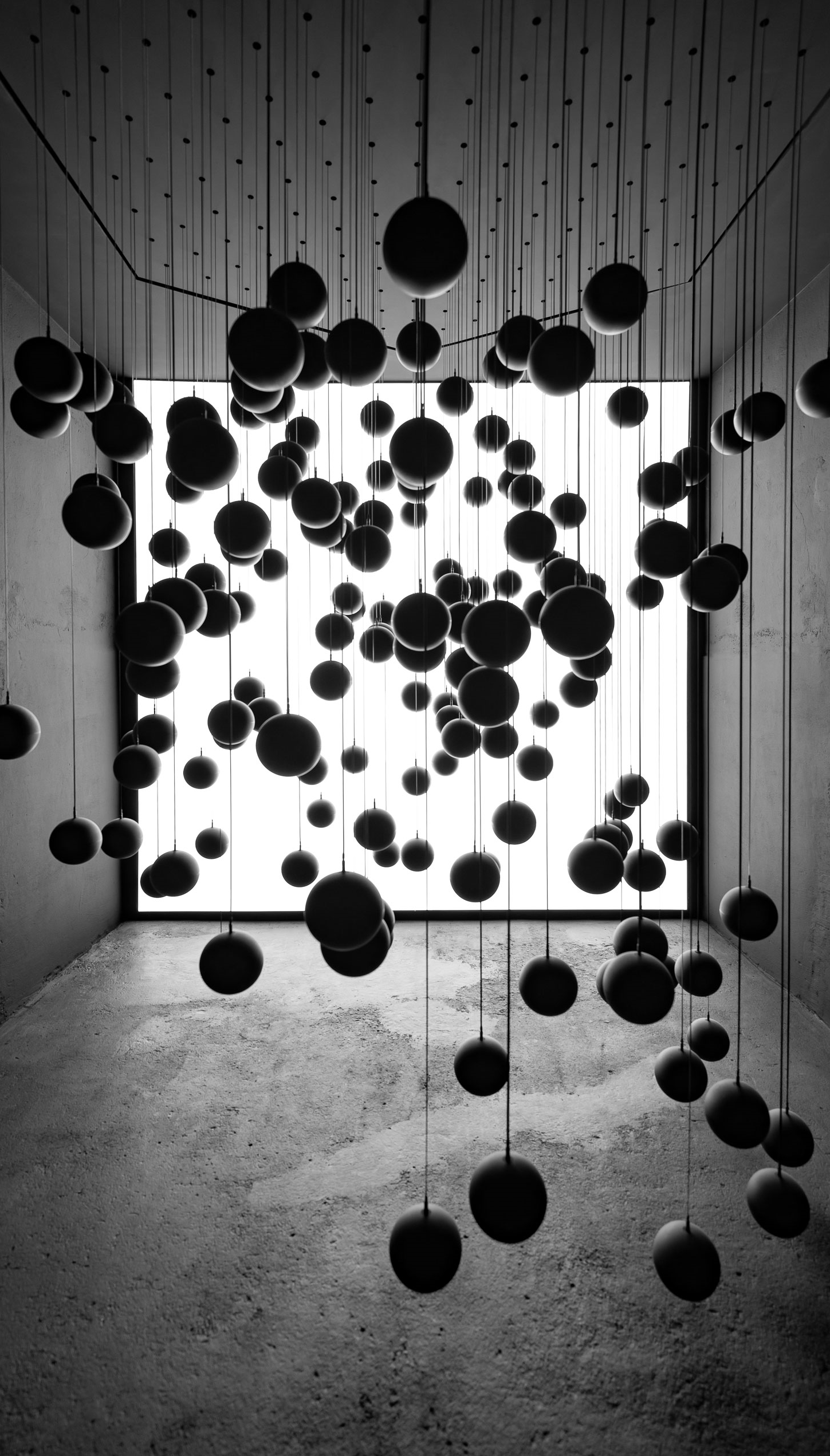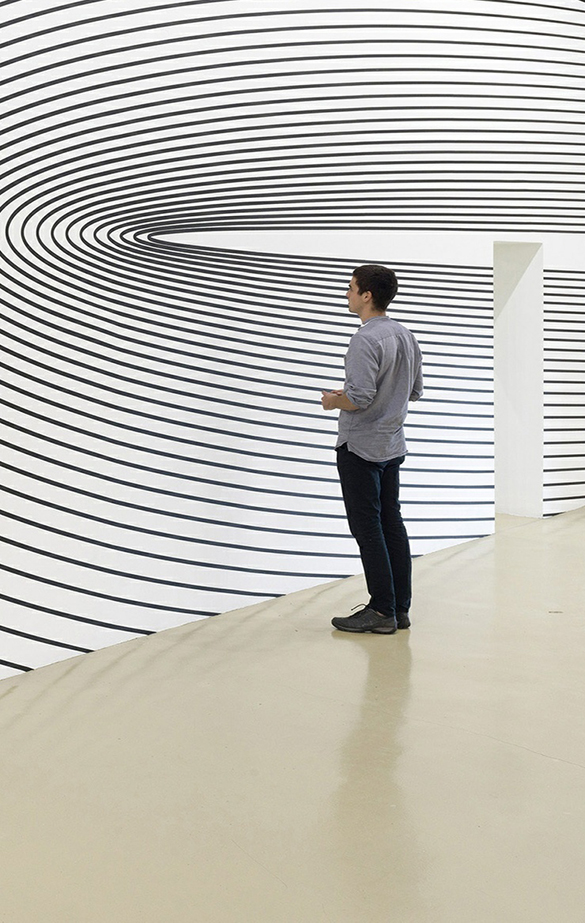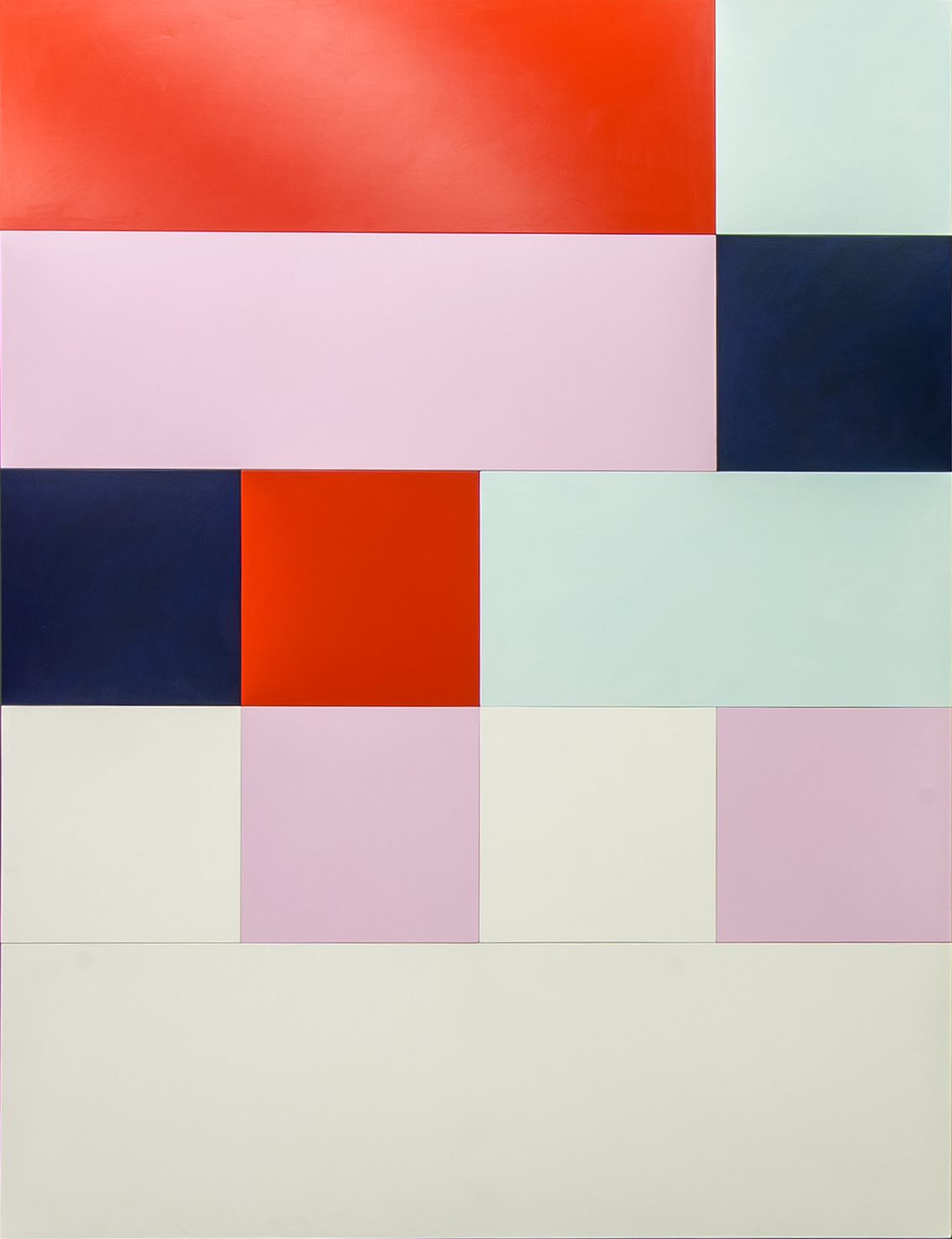
Dark Matter
Inverse
INVERSE combines 169 moving black spherical objects into a seemingly living entity. Monochromatic, sometimes threatening in its appearance, the ensemble presents in silhouette against the bright background.

Inverse
INVERSE combines 169 moving black spherical objects into a seemingly living entity. Monochromatic, sometimes threatening in its appearance, the ensemble presents in silhouette against the bright background.

Park Lage
In the installation, an 11m x 15m x 25m orange inflatable that completely covered the historic courtyard, the viewer accesses the interior of the work and observes how the previously known space, or not, was reconfigured by a monochromatic plastic cover, through which only the shapes of a reality that has just become a work are drawn. This work makes visible a space that was previously just the place where things live. A work that the wind, the sun, the rain and the passing of people keeps alive, breathing.

The coffee cup spring
The monotone repetition of the movement created by the conveyor belt recalls the pace and the landscape of animation or video games. As an extension of the conveyor, several geometric and orthogonal motifs evoking a Tetris composition are slotted together and suggest the shapes of a table, a chair or stairs. The objects are exposed on thin metal structures with fringed ends, and seem to peel off from their construction, as if they were undressing and exchanging skins, depriving themselves of sculptural depth and allowing only the surface to emerge. The technique developed by the artist to produce the sculptures inverts the usual steps of printing: first the pattern is created, then the background to which the fiberglass support is apposed. The pieces are therefore ripped off their mold, revealing their final texture, and the motif on every sculpture seems to remain the same, yet is altered by the shape of the object itself. A series of wall works using this procedure extends from the installation into the gallery space.

WIDE/SIDE
WIDE/SIDE is an interactive installation in which shapes, images, and sounds are joined and interdependent. A visually engaging block, captivating in its monochromatic conception and minimalist lines, serves as a projection screen and teems with conglomerations of lines and shapes. As a result the installation is always changing and acquiring countless different forms.
The individual forms of the projections in reality are based on the surrounding environment, responding to the movements and gestures of the viewers. Visitors and passersby therefore themselves become part of the work and define its appearance.

HOW TO GROW AND STILL STAY THE SAME SHAPE
If Comte’s sculptures are rooted in the naturalness of biomorphic forms, her mural interventions transform surfaces into optical sequences and infinite graphic signs with a digital age aesthetic. The monochromatic vocabulary that invests all her work brings her visually close to the abstraction of Sol LeWitt, Bridget Riley and even John Armleder, an artist with whom she studied. On the occasion of her exhibition at Castello di Rivoli, Comte has carried out a gigantic mural intervention consisting of eleven individual wall paintings specially designed for the galleries on the third floor of the historic residence. Also inspired by some eighteenth-century decorative motifs present on the ceilings and walls of the main museum building, the work develops repeated modules through space.

woman 27
Olga is part of a new generation of young women reshaping the art world from Barcelona. Using social media platforms to gain creative traction, and either blurring the lines between creative genres, she describes herself as an “imager”. Fashion with a documentary edge, strange still-lifes against brightly colored backgrounds, and monochromatic arrangements of ordinary objects. Teo Sandigliano


Double Imposition
Daniel Lefcourt’s monochromatic works criticize and dismantle the processes of painting itself: its inspirations, its materials, and the spaces in which it occurs. Using source material such as photographs of the trash in his studio, Lefcourt creates indecipherable surfaces in low relief that hover between abstract and representational, as well as flat versus textured; The New Yorker has called the artist’s conceptual practice “a surrender to mystery.”

the beach
the national building museum/washington D.C
The BEACH is contained within an enclosure and built out of construction materials such as scaffolding, wooden panels, and perforated mesh, all clad in stark white. Monochromatic beach chairs and umbrellas sprinkle the 50-foot wide “shoreline,” and the “ocean” culminates in a mirrored wall that creates a seemingly infinite reflected expanse.

in transit
Two swift beams of light travel through a room creating infinite shadows on a series of floating white frames. This is In Transit X, a darkened, room-based installation that alludes to an endless void.The dizzying effects of In Transit X place the viewer into a monochromatic man-made space. The fifty-foot-wide animated light installation by artist Hc Gilje was originally made for the Wood Street Galleries in Pittsburgh in 2012, and recently went on display last month at Kulturkirken Jakob in Oslo. Using block-like frames and light as the mediums, Gilje creates dynamic visual dimensions that lend themselves to a mesmerizing noirish experience.

أندريه تاركوفسكي
塔可夫斯基
アンドレイ·タルコフスキー
Андрей Тарковский
nostalghia
From the opening images of Nostalghia (1983), Andrei Tarkovsky presents the two disparate worlds-the spare, monochromatic landscape of the Russian countryside and the lush, idyllic meadows of rural Italy-that collided within the soul of Russian author, Andrei Gortchakov (Oleg Yankovsky). Gortchakov has travelled to Italy on an extended research expedition to retrace the emigrant journey of an acclaimed eighteenth century Russian composer named Pavel Sosnovsky who, despite achieving international recognition away from his homeland, eschewed fame and returned to the humble life of a feudal serf, only to sink further into despair and commit suicide. Gortchakov, accompanied by his translator, Eugenia (Domiziana Giordano), has travelled to the hills of Tuscany to see Piero della Francesca’s Madonna of Childbirth, but upon arriving, becomes disinterested in the attraction, and forgoes the church visit. Left alone at the foothills as Eugenia ventures alone, Gortchakov quotes a resigned passage that reflects his own feelings of inertia: “I’m tired of these sickeningly beautiful sights. I want nothing more just for myself. That’s enough.”
cinema full